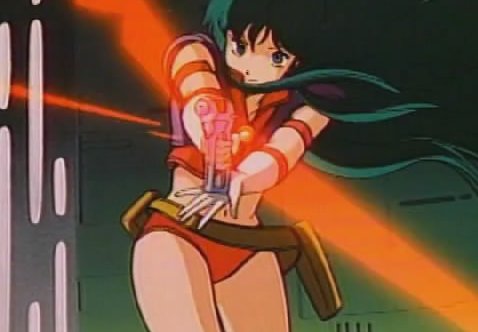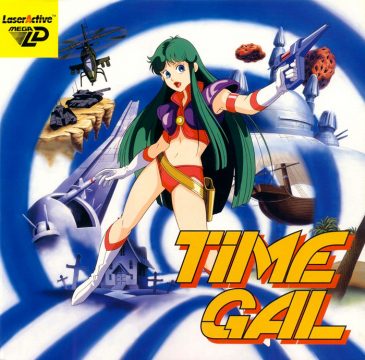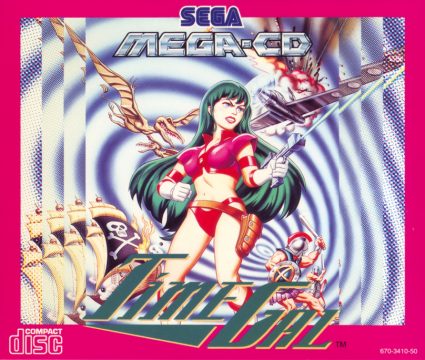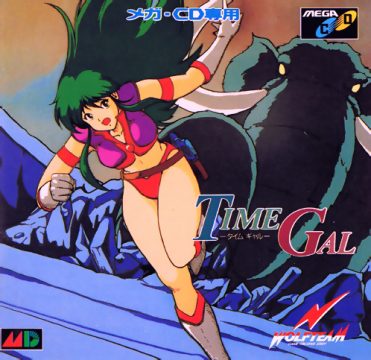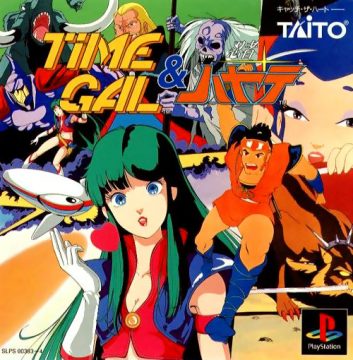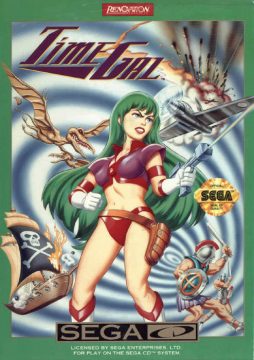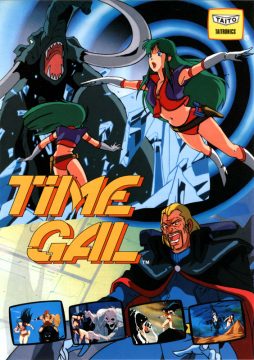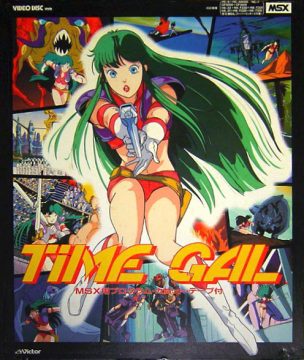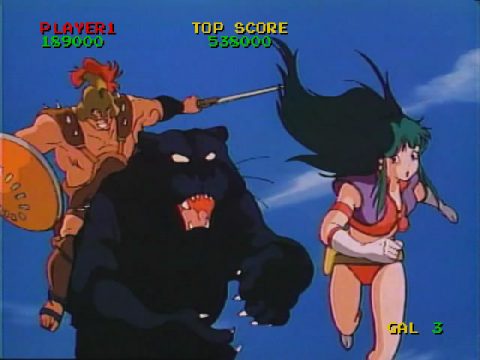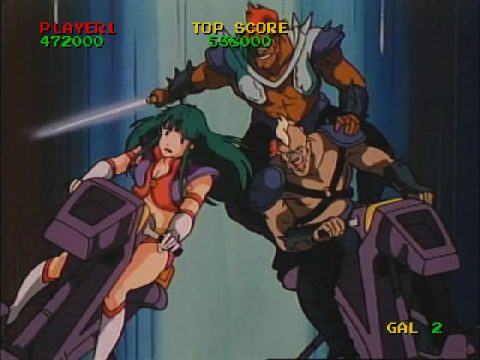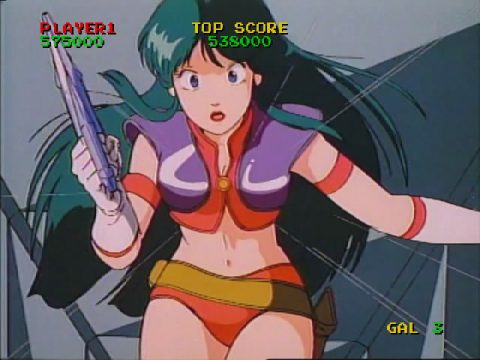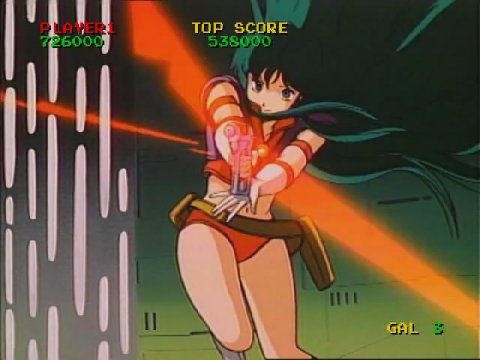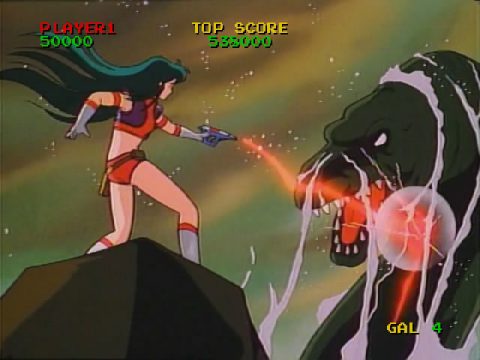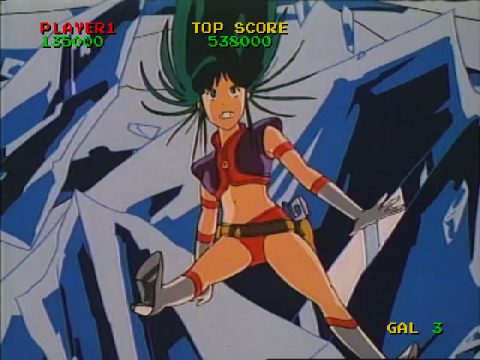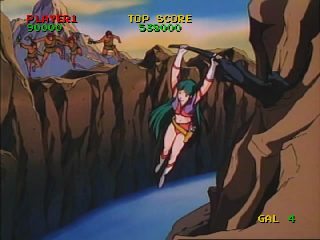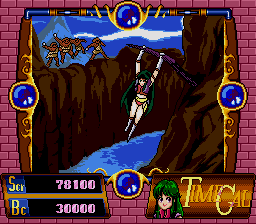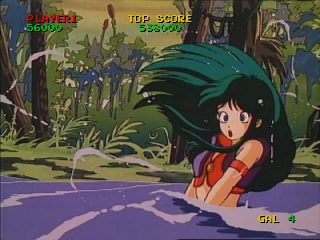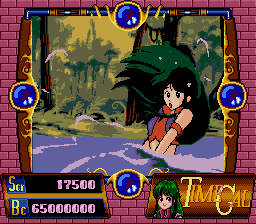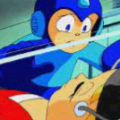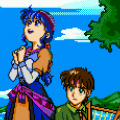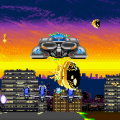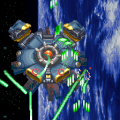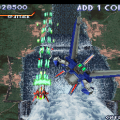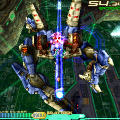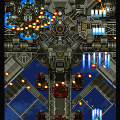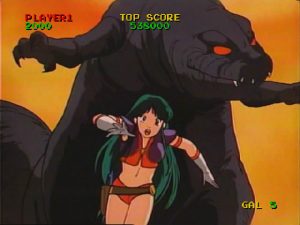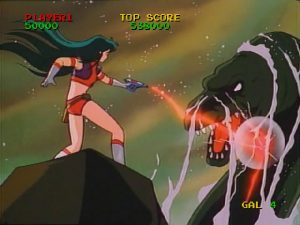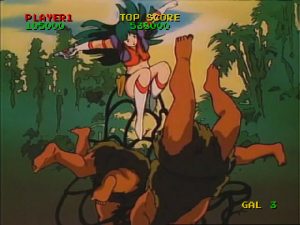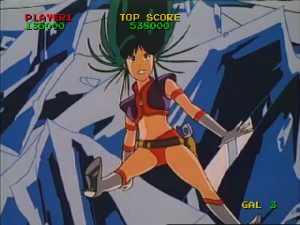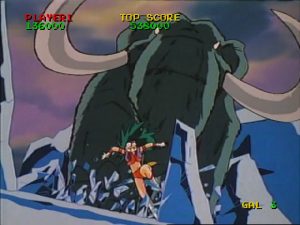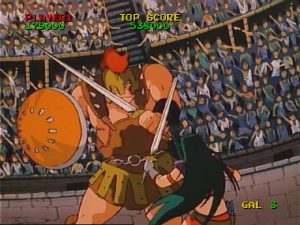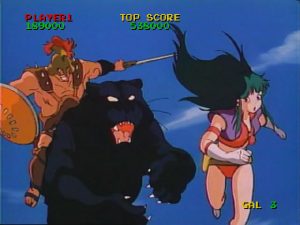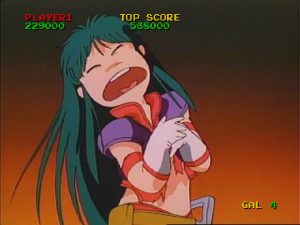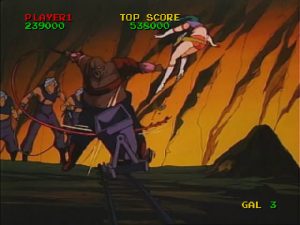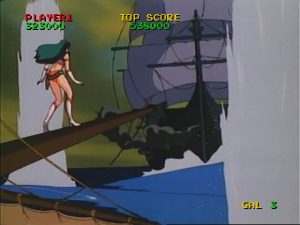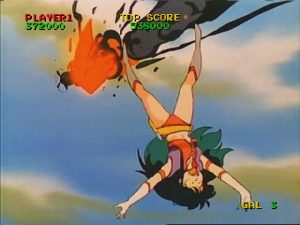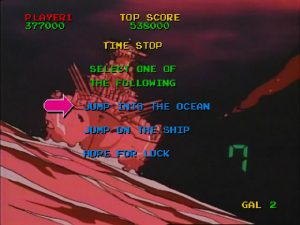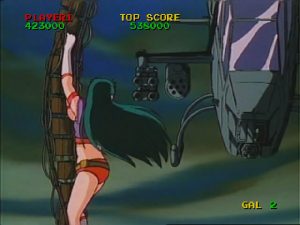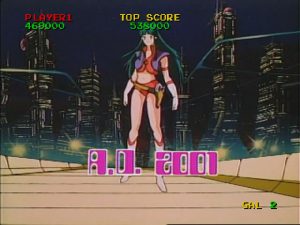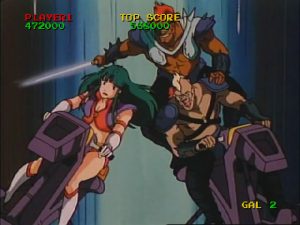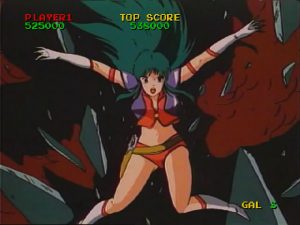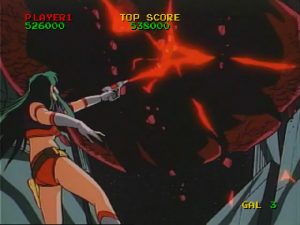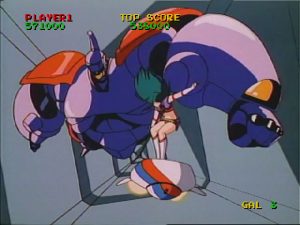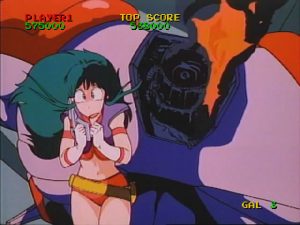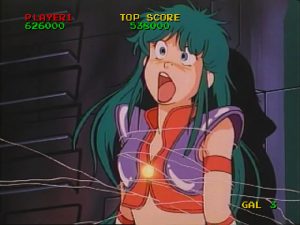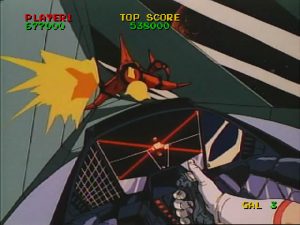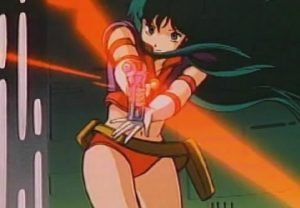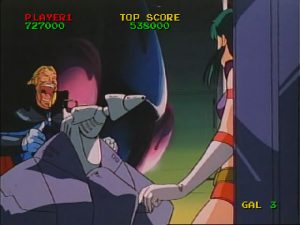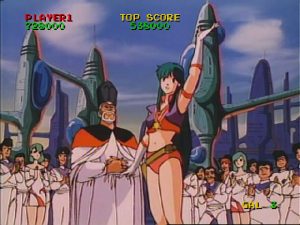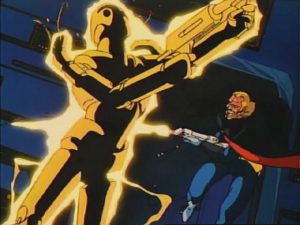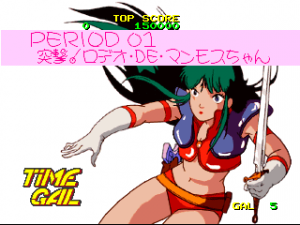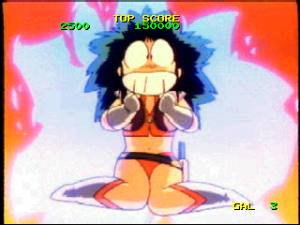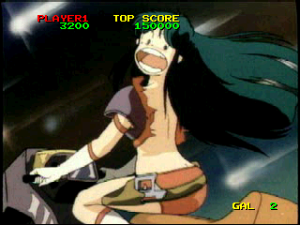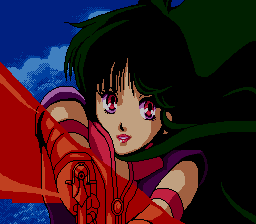ADD MEGA CD PIC
It’s easy to imagine how powerful an impression laserdisc games left on arcade visitors in 1983. In an era where vector graphics and digitized voices were the pinnacle of programming and memory tech, Dragon’s Lair wowed gamers with visuals and sounds straight out of a cartoon – which it essentially was. Pull back the proverbial curtain and the flashy magic trick turns out simple – and expensive: a laserdisc player hooked up with a CPU with the most rudimentary of coding to change video tracks on the fly (even less so if the game itself doesn’t bother keeping score). The gimmick of basically watching a short movie with bare interactive input to keep it rolling was astoundingly lucrative, with Don Bluth’s 10 minute animated fantasy short making 32 times its million dollar budget in 8 months. It wouldn’t take long for the market to get flooded with similar titles and for the novelty to wear off, leaving the new genre running out of steam by the time Space Ace debuted in 1984.
And it wasn’t from a lack of effort – no, scratch that, it was from a lack of effort. Despite many ambitious companies wanting in on the gold rush, not all of them had the backing of an ex-Disney animator’s studio to produce the video for their games. Instead many developers spliced and edited footage from films and anime into a more or less coherent mashing of stages to play through, such a Sega’s Astron Belt swiping from Star Trek II: The Wrath of Khan, Message from Space, and Battle Beyond the Stars, and Stern’s Cliff Hanger using scenes from 2 Lupin III movies: Mystery of Mamo and Castle of Cagliostro. A lot of the character and finesse that made Dragon’s Lair successful was stripped away as many titles haphazardly forced in input and battle sequences with little regard to flow. Even by the release of Bluth’s sequel title, its only contribution was more inputs at a faster clip with quicker reaction time, making the expensive game more of a quarter-muncher. Gamers were becoming sick of seeing the same animations over and over through the trial and error process of memorization. The little arcade nickelodeon shows had lost their luster, and their owners were going back to cheaper cabinets that didn’t require expensive laserdisc players with their high failure rates.
In Japan though, a few publishers were keeping the genre alive. One such company was Taito, who pumped out a few unique titles with moderate success against the changing trends in the mid-80s, complete with original animation from Toei. Time Gal was one of their most memorable of FMV games. The heroine’s experiences and exploits are more in line with Dexter from Space Ace than Dirk the Daring in many ways.
At some point between the 21st century and the 41th, time travel has become a possiblity, and as Timecop, Back to the Future Part II, and Bill and Ted’s Bogus Journey taught us, it is a potentially dangerous tool when placed in the wrong hands. In 4001 AD a criminal named Luda steals an experimental time machine in order to change history and seize power. Fortunately, Reika Kirishima, a.k.a. Time Gal, is able to follow him to the past with her own, much-smaller time traveling medallion on her chest and a laser pistol at her side. Not exactly a deep plot, but enough to justify the perils she’ll face throughout the interactive feature.
As the title explicitly states, Reika is one of the pioneers of playable girls in gaming, she is at least one of the first ostensibly fully human female protagonists created specifically for a video game. Unlike her Kangaroo or Ms. Pac Man forebears, she was neither an animal with maternal instincts nor an abstract yellow disc constantly eating, and unlike Baraduke from the same year, her gender was upfront and on the marquee display. There was no hiding that you were in control of an action heroine – a fairly progressive notion at a time when the majority of arcade games still put the player in the role of a nameless unseen pilot of a spaceship.
Well, it was sort of progressive, but not entirely 100% positive. Female characterization in video games has come under a lot of fire in recent years, and Reika is still a product of her era. Being a long green-haired gal in a half-vest top and red hot pants, she can be described as a blend of Yuri from Dirty Pair, Lum from Urusei Yatsura, and a hint of Milia from Macross. She’s flirty, generally cheerful as she giggles and skips through danger for most of the game, dolling out little quips here and there, with some shrieks of panic when in distress. Her outfit can even get torn off at times when you miss an input. In essence, she embodies what constituted mid-80s anime hotness, for better or for worse.
That isn’t to say it’s all necessarily bad, though. While Reika can come off rather girlish, she is charming and full of personality, if sometimes a bit annoying. She is a lot chattier than Dirk ever was, voiced by Yuriko Yamamoto, known as the Japanese voice of La Mime from Arcadia of my Youth and Yuria from Fist of the North Star. Her flippancy and carefree attitude make her stand out more than a cold, serious tone could have. There are faults in her portrayal, but one of them isn’t blandness. Nor is she outright helpless or bumbling with her acrobatics, dodging strikes from dinosaurs and futuristic laser blasts whilst returning the hot phaser beams back when it’s needed. The fact that a majority of her failure segments has her super deformed and comically injured is a sign that nothing in the game should be taken too seriously, much like many of Dirk’s pratfalls.
The game progresses much like the later Bluth FMV sequel Dragon’s Lair II: Time Warp did years later, with Reika leaping from time period to time period. While not as wacky or as outlandish as Time Warp‘s periods (like the Alice in Wonderland level), Time Gal shows a very loose interpretation of history. Each time period change is randomized, except for the last stage. Many scenes have mirrored variants to prevent too much memorization on the player’s side. The key gimmick that sets Time Gal apart from many other FMV titles is her Time Stop ability, which gives her a few seconds to choose the next course of action from 3 choices. Only one choice is the safe path, and it usually isn’t going guns blazing.
The stages themselves are relatively short but somewhat varied. Here’s a chronological list of the time periods faced through the game:
70,000,000 B.C. – Reika must run away from a dinosaur. More accurately, a theropod that roars like Godzilla and blasts explosive blue breath that zaps the poor Time Gal is she’s not careful. One stomp on the head sends the beast into lava.
65,000,000 B.C. – More dinosaurs, this time in a Cretaceous period jungle/swamp. Aside from a triceratops, there’s plenty of aquatic creatures that want you for supper. Reika even has time to let out a little Tarzan yell as she swings on a vine before it snaps.
30,000 B.C. – Neanderthals gang up to capture/kill our green-haired time traveler. They start with levering some big boulders above you (clever cavemen), tossing stone axes (very clever), and catching you in a big net. (Wait a minute…) There are also pterodactyls to watch out for. (Now that’s just silly!) Don’t shoot the cavemen though, or you’ll disappear due to a time paradox.
16,000 B.C. – A woolly mammoth emerges from the ice-covered tundra/iceberg and gives chase before Reika flips onto its back and rides it until it falls back into the cold watery brink, hopefully without the Time Gal in tow. This is the shortest stage in the entire game and is completed after 3 inputs.
44 B.C. – Reika fights and flirts one-on-one with a Roman gladiator inside a coliseum in front of a crowd (like most people in the game, they don’t seem fazed by a strange skimpy-dressed green-haired lady popping in out of nowhere). It isn’t long before the sword she finds lying around breaks and she’s chased by the warrior and a panther. A few warning phaser shots send them running.
500 A.D. – Slaves build huge stone buildings on a dark cliff side somewhere. Reika must avoid a vicious whipping slave master and ride a very anachronistic complex series of mine carts, Temple of Doom style. This one ends rather abruptly after the master whips your cart.
666 A.D. – A giant ghoul in a spooky graveyard rises from the ground to scythe the Time Gal good. It takes 3 laser blasts to finish him off. A rather short stage, as well. The international Sega CD versions change this time period to 600 A.D.
1588 A.D. – Reika appears on a ship at sea and faces a sole pirate captain, quickly grabbing another conveniently placed sword for some swashbuckling, before another ship in the distance starts lobbing cannonballs. The ensuing battle sinks the ship, and the Time Gal leaps off to safety for another time jump.
1941 A.D. – Reika hops from the wings of Japanese Zero fighters, dodging shots from Allied Forces. She dives into the water, only to confront a submarine and its torpedoes, eventually riding one of them towards an aircraft carrier, where she dodges more Allied planes.
1990 A.D. – Our intrepid Time Gal finds herself on a desert battlefield, dodging tanks and their shells until a helicopter aims its sights on her, chasing her to a rope bridge. Out of many of the blatant errors of history this game makes, it’s eerie how close they were predicting the Gulf War a few years before it happened. The later Sega CD ports changes the date to 1991 to match.
2001 A.D. – The 80s cyberpunk take on the early 21st century. Mohawk punks on hover bikes go after Reika on an overpass, one even wielding a laser sword, before she loses them under a standard oil truck. So much for on-the-spot predictions…
2010 A.D. – A massive space station / battleship / Cybertron planet is being pummeled by meteors! Again, a surprisingly accurate prediction of the near future. This stage is all about running and not being crushed.
3001 A.D. – Another space station, this time seen from the inside. A giant robot beams in behind Reika, Star Trekstyle, and blasts at her. Reika somehow grabs a hover board, and goes on a high-speed chase with the robot.
3999 A.D. – On a desolate spaceship filled with skeletal remains of the crew, Reika must flee (well, mostly skip away) from strange alien monsters that divide when shot and can shoot web to capture her. Her only course of action is to airlock them.
4000 A.D. – Outside of yet another space station (How is she breathing out there?), a couple of star fighters shoot at her before she quickly hops into one herself and blows them away.
4001 A.D. – The last stage, no matter what. Inside the base, Reika must run from a strange monster, blast some robot guards on a series of elevators, then finally confront Luda himself. His Wonder Woman bracelets deflect her laser blasts, but her final Time Stop is done automatically, spinning him around so he blasts the huge reactor behind him, blowing the entire place to smithereens.
And with that officer Reika is rewarded a medal for her duties, despite the sheer amount of temporal paradoxes and changes she possibly created with all her time leaps. It’s never made explici if Luda influenced all these predicaments that Reika must battle through or if she’s merely trying to track him down, always three steps behind, or worse, her time jumps are unreliable. Regardless, everything seems okay in her time, so we can assume no lasting damages were caused by her or the time criminal.
The visuals and animation of the game are well done, being on par with a high-quality anime OVA at the time. It obviously doesn’t match the fluidity of Don Bluth’s works, but suits well to its style, with no outright off-model errors. Unfortunately, the lack of music through most of the game beyond the attraction demo jingle leaves the audio rather vacant at times, aside from whatever quip Reika fills in with. Unlike Don Bluth’s FMV games, no DVD or Blu-Ray remaster seems to exist for this or any other Taito interactive movie title, so laserdisc-quality is the best you can get.
Being an FMV game, it made its rounds on many optical disc-based systems. One of the first was the very rare Japanese computer add-on VHDpc INTER ACTION, which could be plugged into home computers like the MSX or Sharp X1. The add-on ran the caddy-cased Video High Density disc, while the computer itself does the minimal scorekeeping, menu, and input coding grunt work. The format’s focus on non-linear multi-chapter switching made it a perfect system for interactive movie-based video games. Its visual and audio quality is on par with CAV Laserdiscs, but could fall to wear and tear much like magnetic tape-based cassettes or its similar format CED. The VHD had a cult following in Japan, but it was not as wide-spread, leaving the port in rare quantities.
The 1992 Sega CD version, developed by Wolf Team and released in the West by Renovation Products, is the one most people outside of Japan are accustomed to. The port opts for redrawn frames rather than playing a highly-dithered video playback for the low color specs of the system, much akin to the Dragon’s Lair SCD port, which definitely was for the better for the animated visuals. Regardless, the video itself is shrunk to half the screen size with a large border surrounding the action, showing your score data and lives left along with big blue orbs in each direction that flash as helpful aids for the next input (outside of the Hard difficulty, that is). As a cute touch, a chibi profile of Reika sits in the corner winking with each correct button press and makes cartoonish “X” eyes with each failure.
Passwords are given to get you to any level you wish and a Visual Mode is added upon stage completion so you can watch all the scenes and deaths at your leisure. One nice bonus is the new catchy menu music composed by Wolf Team alumnus Motoi Sakuraba. Since this is the only version of Time Gal that was released outside of Japan, the overseas releases have an English voice actress for Reika, who emulates Yuriko Yamamoto’s high-pitched peppy tone. A few of the naughtier fail scenes were censored and the first dinosaur no longer has Godzilla’s trademark roar. Years later, a Mega LD disc for the high-priced Pioneer LaserActive was released, which is the most accurate port for the game available, though it is scarce and therefore fetches an expensive sticker price on the secondhand market. Soon after, Time Gal was bundled with Taito’s earlier FMV title Ninja Hayate on a 2-disc set for both the PlayStation and Saturn. While their video codecs aren’t as high-fidelity as laserdisc, they are quite servable and use the full screen, though the PlayStation version edges out slightly. The same visual auto playback mode from Sega CD is again available through a code or after completing the game.
The Japanese Mega CD version had an exclusive vocal rendition of the theme song played as an intro complete with onscreen credits and lyrics, whereas the Western copies merely had the arcade intro inserted in the standard dithered SCD codec. Also removed from the international Sega CD release was the Wolf Team-added Easter Egg with an above-bust topless shot of Reika shown as a reward for clearing the Hard difficulty.
After starring in her own game, Reika laid low for over 20 years, not staring in a sequel or cameo, until Alfa Systems’s Castle of Shikigami III featured her as a playable character in 2006, where she lends her usual carefree attitude in a new outfit. Her bullets are pretty weak but fire rapidly, and her Time Stop skill serves as her screen-clearing “bomb,” halting the enemies and shots so she can blast them away. As a sort of running gag, no one in the game believes that she is a time traveler. 2011’s Elevator Action Deluxe on PSN received DLC with new levels and playable Taito game character cameos, starring Reika along the likes of Sayo from Pocky & Rocky and the Arkanoid paddle.
It is a little unfortunate that the Time Gal Reika never broke away from the FMV ghetto like Dirk or Dexter did, generally left as a footnote as one of the first high-profile human playable female protagonists in video games. Her chrono-leaping and lasergun-toting antics could’ve crossed over as a run-‘n-gun action side-scroller relatively easy and might’ve kept her from being forgotten so easily. But who knows, maybe Taito might give her another starring role or another cameo in the future, or at least the original game could be re-released for the latest digital formats. For now, she exists as a relic of gaming’s past, when newfangled gimmicks could draw players in through simple video playback, and yet ironically ahead of her time.
Links:
Youtube Valis77’s longplay of the arcade game
Youtube A Retsupurae of the above longplay
Youtube A compilation of all failure scenes
Youtube Japanese Mega CD intro
All arcade screenshots were taken from Valis77’s longplay
Screenshot Comparisons
